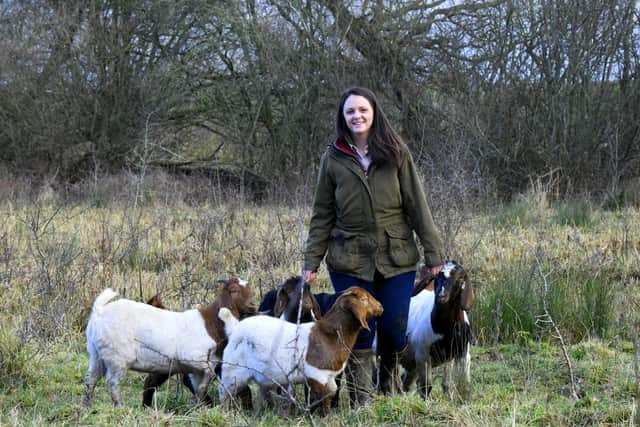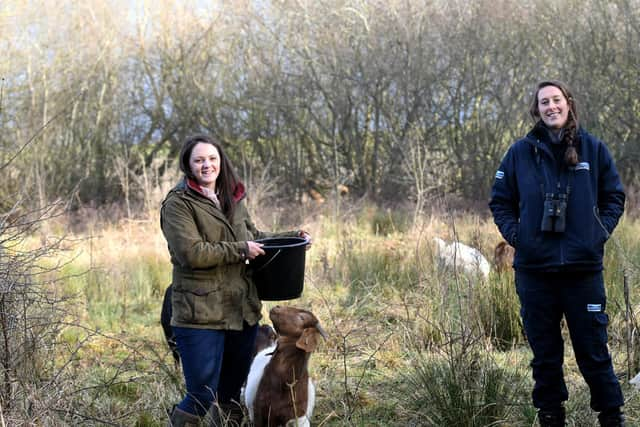A herd of seven Boer goats are helping with conservation grazing at a nature reserve in a new venture for farmer Charlotte Taylor
The goats, owned by Charlotte Taylor, join a herd of Belted Galloway cattle managed by her partner, Ben Freeman.
Goats have become an increasingly popular form of livestock as demand for their meat and milk continues to grow.
Advertisement
Hide AdAdvertisement
Hide AdGrowing up on an arable farm, Charlotte’s career has seen her working with poultry, pigs and as a bio security adviser before starting her goat herd with a gift from Ben.


“We started with the goats when Ben bought me two male Boers as a surprise,” Charlotte said.
“It was a random conversation between Ben and his farm boss that brought about the idea that goats could do a job at Tophill Low nature reserve, not far from where he works.
“Ben currently grazes Belted Galloway cattle there for his boss and they are there to improve the natural habitat by eating down the vegetation.”
Advertisement
Hide AdAdvertisement
Hide AdWith goats having a wide dietary range and feeding behaviour which means they will target more fibrous vegetation, they will tackle the hardier vegetation on the site other livestock ignores.


“The idea is that the goats will eat off what the Belted Galloways don’t and that saves Yorkshire Water, which operate the nature reserve, hours in manual labour cutting back such as brambles and hawthorn.
“When it was decided that we should give the grazing a try we went back to the lady Ben bought the first two from to expand the herd.
“We took on another five Boers, all females. Three are youngsters while the other two are in-kid.”
Advertisement
Hide AdAdvertisement
Hide AdNibbles, Dodge, Elderflower, Betsy, Lily, Lucy and Lara are currently grazing the hay meadows on the 300-acre site.
“They are doing quite well on the 16 acres and now go under the herd name Nibbles & Co.”
Charlotte said she also has plans to buy more kids aged between eight and nine months and set up a breeding programme.
She said she has also contacted local farm shops with a view to selling goat meat which is currently enjoying a surge in appeal.
Advertisement
Hide AdAdvertisement
Hide Ad“I’m interested in selling goat meat and plan to go on a butchery course,” said Charlotte.
“How it is all going to work out is still a work in progress but I’m doing a lot of research into what works best. I’m already considering crossing a Toggenburg or a British Alpine.”
Throughout her career, Charlotte has shown an entrepreneurial streak and appetite for learning.
At the age of around 15 and working on a poultry unit at Rivis’ farm in Hull, Charlotte said she had wanted to find out about different laying hens.
Advertisement
Hide AdAdvertisement
Hide Ad“I rang dad one day after I’d got home from the farm with ten hens and asked what he would do if I brought them home. He just said: ‘You’ve already done it haven’t you?’
“I was so interested and I ended up with 40 layers of all breeds including Light Sussex, Black Rock, Rhode Island Red and Menorcan Bantam.
“We would breed from them and give eggs to family and friends.”
And when the first lockdown curtailed her bio security work, Charlotte’s flexibility meant she was able to turn her hand to something new.
Advertisement
Hide AdAdvertisement
Hide AdAs well as expanding the goat herd and with an interest in sustainable farming, she started making rugs.
“I’m a big believer in sustainable farming and not wasting anything so I began learning about wool.”
Using alpaca fleeces at first, Charlotte began wet felting rugs, which is a method of making rugs which does not use the skin as backing.
“Wet felting is all about the wool, hot water, soap and agitation, that’s how the wool naturally felts,” Charlotte explained.
Advertisement
Hide AdAdvertisement
Hide AdWorking under the brand name The Woolly Moose, Charlotte has increased her product line using all kinds of British wool.
“I’ve made about 20 rugs so far, but the demand for all things woolly has been amazing,” she said.
“I’ve even made a life-size Highland cow’s head out of wool.”
Her current lines include rugs using both alpaca and sheep’s wool, animal beds, throws, fleecy cushion covers and insoles.
Advertisement
Hide AdAdvertisement
Hide AdCharlotte and Ben’s ambition is to run a farm of their own. The couple met through a Tesco Future Farming Foundation course that started in early 2018.
“An advertisement for the course kept popping up on Facebook,” Charlotte said.
“I’m always trying to better myself and I’m really ambitious so it interested me, but I didn’t do anything about it until the deadline day when I finally thought ‘I’ve nothing to lose’.
“I went for an interview and was fortunate enough to be given one of the 50 places available for 21 to 35-year-olds.
Advertisement
Hide AdAdvertisement
Hide Ad“It was billed as bridging the gap between producers and supermarkets.
“We visited Muller, Tesco’s red meat division, Avara Food Group and Dawnfresh. It was a great experience.”
It was there she met first generation farmer, Ben from Lancashire.
“Our dream would be to have our own farm with our own herd of cattle and probably now also a goat herd, selling our own beef and goat direct from the farm as well as supplying others.”
Advertisement
Hide AdAdvertisement
Hide AdCharlotte said she is also passionate about opening up opportunities for other young people to find careers in agriculture.
“I’d like to start a rural education centre for young people.
“When I was in the sixth form at school in Hornsea and despite having grown up in a rural area, agriculture was never once mooted as a career.
“There is a world of opportunities and careers within agriculture which often young people are never told about.
“It’s time to show young people that farming has so much to offer young people.”
Comment Guidelines
National World encourages reader discussion on our stories. User feedback, insights and back-and-forth exchanges add a rich layer of context to reporting. Please review our Community Guidelines before commenting.